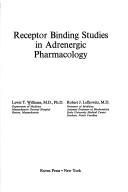| Listing 1 - 10 of 11 | << page >> |
Sort by
|
Book
Year: 1959 Publisher: Bruges : St. Catherine Press,
Abstract | Keywords | Export | Availability | Bookmark
 Loading...
Loading...Choose an application
- Reference Manager
- EndNote
- RefWorks (Direct export to RefWorks)

ISBN: 0124629202 Year: 1983 Publisher: New York : Academic Press,
Abstract | Keywords | Export | Availability | Bookmark
 Loading...
Loading...Choose an application
- Reference Manager
- EndNote
- RefWorks (Direct export to RefWorks)
Methoxyhydroxyphenylglycol --- Methoxyhydroxyphenylglycol --- Norepinephrine --- Adrenergic mechanisms. --- Methoxyhydroxyphenylglycol --- Methoxyhydroxyphenylglycol --- Norepinephrine --- Analysis. --- Diagnostic use. --- Metabolism. --- analysis. --- diagnostic use. --- metabolism.
Book
Year: 2020 Publisher: Frontiers Media SA
Abstract | Keywords | Export | Availability | Bookmark
 Loading...
Loading...Choose an application
- Reference Manager
- EndNote
- RefWorks (Direct export to RefWorks)
This eBook is a collection of articles from a Frontiers Research Topic. Frontiers Research Topics are very popular trademarks of the Frontiers Journals Series: they are collections of at least ten articles, all centered on a particular subject. With their unique mix of varied contributions from Original Research to Review Articles, Frontiers Research Topics unify the most influential researchers, the latest key findings and historical advances in a hot research area! Find out more on how to host your own Frontiers Research Topic or contribute to one as an author by contacting the Frontiers Editorial Office: frontiersin.org/about/contact
Science: general issues --- Psychology --- neurotransmitters --- emotions --- dopamine --- monoamine --- norepinephrine
Book
Year: 2019 Publisher: Frontiers Media SA
Abstract | Keywords | Export | Availability | Bookmark
 Loading...
Loading...Choose an application
- Reference Manager
- EndNote
- RefWorks (Direct export to RefWorks)
This eBook is a collection of articles from a Frontiers Research Topic. Frontiers Research Topics are very popular trademarks of the Frontiers Journals Series: they are collections of at least ten articles, all centered on a particular subject. With their unique mix of varied contributions from Original Research to Review Articles, Frontiers Research Topics unify the most influential researchers, the latest key findings and historical advances in a hot research area! Find out more on how to host your own Frontiers Research Topic or contribute to one as an author by contacting the Frontiers Editorial Office: frontiersin.org/about/contact
Medicine --- Endocrinology --- Glucocorticoids --- Growth hormone --- Sympathetic innervation --- Galectins --- Thymus --- Norepinephrine --- Ephrins --- Diabetes --- Infectious diseases --- Cytokines

ISBN: 0861962931 9780861962938 Year: 1991 Publisher: Paris Fabre
Abstract | Keywords | Export | Availability | Bookmark
 Loading...
Loading...Choose an application
- Reference Manager
- EndNote
- RefWorks (Direct export to RefWorks)
Blood physiology. Circulatory physiology --- Microcirculation --- Norepinephrine --- Veins --- physiopathology --- congresses --- physiology --- Pulmonary Circulation --- Venous Insufficiency --- Microcirculation. --- pharmacology. --- drug effects. --- drug therapy. --- physiology. --- physiopathology. --- NOREPINEPHRINE --- PULMONARY CIRCULATION, drug effects --- VENOUS INSUFFICIENCY, drug therapy --- MICROCIRCULATION --- VEINS --- pharmacology --- Physiopathology --- Pharmacology --- Physiology --- Pulmonary circulation, drug effects --- Venous insufficiency, drug therapy --- congresses. --- Microvascular Blood Flow --- Microvascular Circulation --- Blood Flow, Microvascular --- Circulation, Microvascular --- Flow, Microvascular Blood --- Microvascular Blood Flows --- Microvascular Circulations --- drug effects --- drug therapy --- Microcirculation - physiopathology --- Veins - physiopathology --- Norepinephrine - physiology --- Microcirculation - congresses --- Veins - congresses --- Norepinephrine - congresses
Book
ISBN: 0444800832 Year: 1978 Publisher: Amsterdam Elsevier/North-Holland biomedical press
Abstract | Keywords | Export | Availability | Bookmark
 Loading...
Loading...Choose an application
- Reference Manager
- EndNote
- RefWorks (Direct export to RefWorks)
Receptors, Adrenergic --- Drug effects --- Congresses. --- Physiology --- Receptors, Adrenergic. --- 615.21 --- Adrenergic Receptor --- Epinephrine Receptors --- Norepinephrine Receptors --- Adrenergic Receptors --- Adrenoceptors --- Receptors, Epinephrine --- Receptors, Norepinephrine --- Receptor, Adrenergic --- Epinephrine --- Norepinephrine --- Sympathomimetics --- Racepinephrine --- drug effects. --- physiology. --- Agents predominantly affecting the nervous system --- Adrenaline --- Adrenergic mechanisms --- Neuropharmacology --- Sympathomimetic agents --- Pharmacology --- Receptors --- Effect of drugs on --- Textbooks & monographs 1891-2000 --- Textbooks & monographs 1891-2000. --- 615.21 Agents predominantly affecting the nervous system --- Adrenergic activators --- Adrenergic agents --- Adrenomimetics --- Sympathetic transmitter releasers --- Autonomic drugs --- Biomimetics --- Sympathetic nervous system --- Adrenalin --- Bronchodilator agents --- Catecholamines --- Neurotransmitters --- Receptors&delete& --- Congresses --- Effect of drugs on&delete& --- drug effects --- physiology --- Adrenoceptor --- Norepinephrine Receptor --- Receptor, Norepinephrine
Book
ISBN: 1615042326 1615042318 Year: 2011 Publisher: San Rafael, Calif. (1537 Fourth Street, San Rafael, CA 94901 USA) : Morgan & Claypool,
Abstract | Keywords | Export | Availability | Bookmark
 Loading...
Loading...Choose an application
- Reference Manager
- EndNote
- RefWorks (Direct export to RefWorks)
The kidney is innervated with efferent sympathetic nerve fibers reaching the renal vasculature, the tubules, the juxtaglomerular granular cells, and the renal pelvic wall. The renal sensory nerves are mainly found in the renal pelvic wall. Increases in efferent renal sympathetic nerve activity reduce renal blood flow and urinary sodium excretion by activation of [beta]1-adrenoceptors and increase renin secretion rate by activation of [beta]1-adrenoceptors. In response to normal physiological stimulation, changes in efferent renal sympathetic nerve activity contribute importantly to homeostatic regulation of sodium and water balance. The renal mechanosensory nerves are activated by stretch of the renal pelvic tissue produced by increases in renal pelvic tissue of a magnitude that may occur during increased urine flow rate. Activation of the sensory nerves elicits an inhibitory renorenal reflex response consisting of decreases in efferent renal sympathetic nerve activity leading to natriuresis. Increasing efferent sympathetic nerve activity increases afferent renal nerve activity which, in turn, decreases efferent renal sympathetic nerve activity by activation of the renorenal reflexes. Thus, activation of the afferent renal nerves buffers changes in efferent renal sympathetic nerve activity in the overall goal of maintaining sodium balance. In pathological conditions of sodium retention, impairment of the inhibitory renorenal reflexes contributes to an inappropriately increased efferent renal sympathetic nerve activity in the presence of sodium retention. In states of renal disease or injury, there is a shift from inhibitory to excitatory reflexes originating in the kidney. Studies in essential hypertensive patients have shown that renal denervation results in long-term reduction in arterial pressure, suggesting an important role for the efferent and afferent renal nerves in hypertension.
Kidneys. --- Biological control systems. --- Kidneys --- Kidney --- Innervation. --- efferent renal sympathetic nerves --- afferent renal nerves --- norepinephrine --- substance P --- renal innervation --- renal mechanosensory nerves --- adrenoceptors --- prostaglandins --- sodium --- renin secretion --- hypertension

ISBN: 0890041644 9780890041642 Year: 1978 Publisher: New York (N.Y.): Raven
Abstract | Keywords | Export | Availability | Bookmark
 Loading...
Loading...Choose an application
- Reference Manager
- EndNote
- RefWorks (Direct export to RefWorks)
Pharmacology. Therapy --- Adrenergic mechanisms --- Adrenergic receptors --- Radioligand assay --- Receptors, Adrenergic --- Binding sites --- Adrenaline --- Radioligand Assay --- BINDING SITES --- RECEPTORS, ADRENERGIC --- Receptors --- Binding Sites. --- Radioligand Assay. --- Receptors, Adrenergic. --- -Adrenergic mechanisms --- #Lilly --- Binding assay, Radioligand --- Competitive protein binding assay --- Ligand binding assay (Biochemistry) --- Protein binding assay --- Radioreceptor assay --- Receptor binding assay --- Tissue receptor assay --- Analytical biochemistry --- Ligand binding (Biochemistry) --- Protein binding --- Sympathetic nervous system --- Adrenalin --- Epinephrine --- Bronchodilator agents --- Catecholamines --- Neurotransmitters --- Sympathomimetic agents --- Adrenergic Receptor --- Epinephrine Receptors --- Norepinephrine Receptors --- Adrenergic Receptors --- Adrenoceptors --- Receptors, Epinephrine --- Receptors, Norepinephrine --- Receptor, Adrenergic --- Norepinephrine --- Sympathomimetics --- Racepinephrine --- Protein-Binding Radioassay --- Radioreceptor Assay --- Assay, Radioligand --- Assay, Radioreceptor --- Assays, Radioligand --- Assays, Radioreceptor --- Protein Binding Radioassay --- Protein-Binding Radioassays --- Radioassay, Protein-Binding --- Radioassays, Protein-Binding --- Radioligand Assays --- Radioreceptor Assays --- Ligands --- Protein Binding --- Binding Site --- Combining Site --- Combining Sites --- Site, Binding --- Site, Combining --- Sites, Binding --- Sites, Combining --- Protein Interaction Mapping --- Receptors. --- Binding Sites --- Adrenoreceptors --- Adrenoceptor --- Norepinephrine Receptor --- Receptor, Norepinephrine --- Adrenaline - Receptors
Book
ISBN: 3039217038 303921702X Year: 2019 Publisher: MDPI - Multidisciplinary Digital Publishing Institute
Abstract | Keywords | Export | Availability | Bookmark
 Loading...
Loading...Choose an application
- Reference Manager
- EndNote
- RefWorks (Direct export to RefWorks)
The prefrontal cortex (PFC) plays a pivotal role in regulating our emotions. The importance of ventromedial regions in emotion regulation, including the ventral sector of the medial PFC, the medial sector of the orbital cortex and subgenual cingulate cortex, have been recognized for a long time. However, it is increasingly apparent that lateral and dorsal regions of the PFC, as well as neighbouring dorsal anterior cingulate cortex, also play a role. Defining the underlying psychological mechanisms by which these functionally distinct regions modulate emotions and the nature and extent of their interactions is a critical step towards better stratification of the symptoms of mood and anxiety disorders. It is also important to extend our understanding of these prefrontal circuits in development. Specifically, it is important to determine whether they exhibit differential sensitivity to perturbations by known risk factors such as stress and inflammation at distinct developmental epochs. This Special Issue brings together the most recent research in humans and other animals that addresses these important issues, and in doing so, highlights the value of the translational approach.
norepinephrine --- medial prefrontal cortex --- fear extinction --- emotion regulation --- emotion processing --- connectivity --- anticipatory arousal --- Pavlovian --- triadic neural systems model --- prelimbic --- development --- positive and negative --- rat --- Williams Syndrome --- psychological treatment --- glia density --- anxiety --- fMRI --- area 25 --- anhedonia --- adolescence --- adolescent --- autonomic --- amygdala --- neuron density --- neural --- prefrontal cortex --- reliability --- functional magnetic resonance imaging (fMRI) --- networks --- cAMP --- cognitive control --- extinction --- infralimbic --- NMDA --- reward --- calcium --- stress adolescence --- BDNF --- machine learning --- negative affect --- hierarchical control --- emotion --- occasion setting --- serotonin transporter --- ventromedial prefrontal cortex --- psychophysiology --- depression --- aging --- dopamine --- age
Book
Year: 2022 Publisher: MDPI - Multidisciplinary Digital Publishing Institute
Abstract | Keywords | Export | Availability | Bookmark
 Loading...
Loading...Choose an application
- Reference Manager
- EndNote
- RefWorks (Direct export to RefWorks)
Mounting evidence suggests a bidirectional relationship between metabolism and inflammation. Molecular crosstalk between these processes occurs at different levels with the participation of nuclear receptors, including peroxisome proliferator-activated receptors (PPARs). There are three PPAR isotypes, α, β/δ, and γ, which modulate metabolic and inflammatory pathways, making them key for the control of cellular, organ, and systemic processes. PPAR activity is governed by fatty acids and fatty acid derivatives, and by drugs used in clinics (glitazones and fibrates). The study of PPAR action, also modulated by post-translational modifications, has enabled extraordinary advances in the understanding of the multifaceted roles of these receptors in metabolism, energy homeostasis, and inflammation both in health and disease. This Special Issue of IJMS includes a broad range of basic and translational article, both original research and reviews, focused on the latest developments in the regulation of metabolic and/or inflammatory processes by PPARs in all organs and the microbiomes of different vertebrate species.
Research & information: general --- Biology, life sciences --- Biochemistry --- nuclear receptor --- gene transcription --- inflammation --- molecular docking --- PPARβ/δ --- lung --- pulmonary artery --- GW0742 --- GSK3787 --- docking --- lipopolysaccharide (LPS) --- PPARγ ligand --- coumarin --- fluorescent ligand --- screening --- crystal structure --- PPAR --- atopic dermatitis --- psoriasis --- metabolic reprograming --- glucose --- fatty acids --- mycobacteria --- M. tuberculosis --- M. leprae --- PPARs --- lipid droplets --- metabolic alterations --- hepatic damage --- nuclear factors --- pharmacological targets --- AMPK --- GDF15 --- insulin resistance --- type 2 diabetes mellitus --- peroxisome proliferator-activated receptor gamma (PPARγ) --- real-time PCR --- ELISA --- immunohistochemistry --- signaling pathway --- PPAR gamma --- brain --- neural stem cells --- infection --- neuroinflammation --- HIV --- Zika --- cytomegalovirus --- neurogenesis --- microglia --- liver damage --- toll-like receptor 4 --- P2Y2 receptor --- metabolic syndrome --- resveratrol --- quercetin --- PPARα --- peroxisome --- β-oxidation --- PPRE --- ligand --- coregulator --- micronutrients --- PPARα knockout --- adipose tissue --- browning --- lipid metabolism --- depression --- PPARg --- neuropathology --- corticotropin releasing hormone --- norepinephrine --- subgenual prefrontal cortex --- amygdala --- nucleus accumbens --- common carotid artery occlusion --- electroretinography --- fibroblast growth factor 21 --- pemafibrate --- peroxisome proliferator-activated receptor alpha --- retinal ischemia --- skeletal muscle --- substrate metabolism --- nonalcoholic fatty liver disease (NAFLD) --- sex dimorphism --- lipidomics --- hepatic sex-biased gene expression --- PPARγ --- pulmonary arterial hypertension --- TGFβ --- vascular injury --- proliferation --- kidney fibrosis --- pattern-recognition receptors --- phagocytosis --- nitric oxide synthase --- fenofibrate --- oleoylethanolamide --- palmitoylethanolamide --- cancer --- immunity --- obesity --- diabetes --- miRNA --- DNA methylation --- histone modification --- peroxisome-proliferator-activated receptor --- fatty acid oxidation --- doping control --- regulatory T cells --- exercise --- nuclear receptors --- nutrigenomics --- energy homeostasis --- dairy animals --- non-alcoholic fatty liver disease (NAFLD) --- non-alcoholic steatohepatitis (NASH) --- peroxisome proliferator-activated receptors (PPAR) --- bezafibrate --- fenofibric acid --- peroxisome proliferator-activated receptor --- dual/pan agonist --- X-ray crystallography --- n/a
| Listing 1 - 10 of 11 | << page >> |
Sort by
|

 Search
Search Feedback
Feedback About UniCat
About UniCat  Help
Help News
News